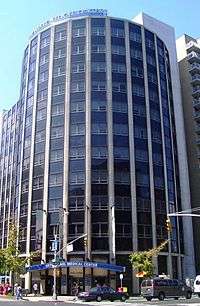Mount Sinai Beth Israel
| Mount Sinai Beth Israel | |
|---|---|
| Mount Sinai Health System | |
 | |
 Linsky Pavilion of the Petrie Division on First Avenue and 16th Street in Manhattan. This façade has appeared in many sitcoms, including Friends. | |
| Geography | |
| Location |
First Avenue at 16th Street, New York City, NY, United States |
| Coordinates | 40°44′01″N 73°58′57″W / 40.7335°N 73.9826°WCoordinates: 40°44′01″N 73°58′57″W / 40.7335°N 73.9826°W |
| Organization | |
| Funding | Non-profit hospital |
| Hospital type | Teaching |
| Affiliated university | Icahn School of Medicine at Mount Sinai |
| Network | Mount Sinai Health System |
| Services | |
| Emergency department | Level II trauma center |
| Beds | 799[1] |
| History | |
| Founded | 1889[1] |
| Links | |
| Website |
www |
| Lists | Hospitals in the United States |
Mount Sinai Beth Israel is a 799-bed teaching hospital in New York City.[1] It is part of the Mount Sinai Health System, a nonprofit health system formed in September 2013 by the merger of Continuum Health Partners and Mount Sinai Medical Center, and an academic affiliate of the Icahn School of Medicine at Mount Sinai.
History
Beth Israel is Hebrew for "House of Israel." The hospital was incorporated at Beth Israel Hospital on May 28, 1890 by a group of 40 Orthodox Jews on the Lower East Side of Manhattan, each of whom paid 25 cents to set up a hospital dedicated to serving immigrant Jews living in the tenement slums of the Lower East Side of Manhattan. At the time, most of New York's hospitals would not treat patients who had been in the city less than a year. It initially opened a dispensary at 206 Broadway in 1891, and moved to Jefferson and Cherry Streets in 1895.[2] On March 12, 1929, it moved to First Avenue and 16th Street, facing Stuyvesant Square, and the old building was converted into a old age home, the Home of Old Israel.[3][4][5] It purchased its neighbor Manhattan General Hospital in 1964 and was renamed Beth Israel Medical Center on March 10, 1965.[6].

By then it had extended beyond its Jewish base and served the entire population of Lower Manhattan including Manhattan's Lower East Side, Chinatown, Gramercy, the West Village, Chelsea. In 1988 it had the largest network of heroin-treatment clinics in the United States with 7,500 patients and 23 facilities.[7] It acquired Doctors Hospital on the Upper East Side in the 1990s, renaming it Beth Israel Medical Center-Singer Division, and Kings Highway Hospital Center in Brooklyn in 1995, renaming it Beth Israel Medical Center-Kings Highway Division. In 2004, the Singer Division closed and the Manhattan inpatient operations were consolidated in the buildings on First Avenue at 16th Street in Manhattan.
As of 2010 Mount Sinai Beth Israel had residency training programs in nearly every major field of medicine including Emergency Medicine, Internal Medicine, Surgery, Otolaryngology, Oral and maxillofacial surgery, Radiology, Family Medicine, Dermatology, Obstetrics and Gynecology, Neurology, Ophthalmology, Pathology, Psychiatry, Podiatry, and Urology. Mount Sinai Beth Israel also has a department of Chiropractic,[8] Music Therapy, and Acupuncture.
On November 22, 2013 the name of Beth Israel Medical Center was changed to Mount Sinai Beth Israel as a part of the merger with Mount Sinai to form the Mount Sinai Health System.
On May 25, 2016, Mount Sinai announced a significant restructuring and downsizing, with plans to build a new hospital with only 70 inpatient beds on a site several blocks away. This is expected to take over four years, after which the main hospital on 16th Street will be closed and that site will be sold.[9]
On June 11, 2017, the hospital's Labor and Delivery Department closed.[10] The hospital's "Continuum Center for Health and Healing" also closed in 2017.[11]
References
- 1 2 3 "About the hospital". Icahn School of Medicine at Mount Sinai. Retrieved April 14, 2017.
- ↑ Walsh, James J. (1919). History of Medicine in New York – Three Centuries of Medical Progress. New York, N.Y.: National Americana Society. Retrieved 4 October 2015.
- ↑ "Hospital to Open Today – Each Patient Will Have a Private Room at New Beth Israel". New York Times. March 12, 1929. p. 11. Retrieved 13 May 2018.
- ↑ "Beth Israel Opens With 40 Patients – Boy Who Broke Arm in Park Is First to Be Received in New Hospital Building – 500 Private Rooms Ready – Dedication Put Off Until President Hoover, Who Laid Cornerstone, Can Attend Ceremony". New York Times. March 13, 1929. p. 20. Retrieved 13 May 2018.
- ↑ "New Jewish Home Opened – Parade of 1,000 Precedes Dedication of Old Israel Institution". New York Times. October 26, 1931. p. 3. Retrieved 26 March 2018.
- ↑ "New Chief, New Name for Hospital". New York Times. March 11, 1965. p. 22. Retrieved 12 October 2015.
- ↑ "CBSi". findarticles.com.
- ↑ Staff. "Our Physicians". Beth Israel Medical Center. Retrieved January 1, 2014.
- ↑ Santora, Marc (May 25, 2016). "Mt. Sinai Beth Israel Hospital in Manhattan Will Close to Rebuild Smaller". The New York Times. Retrieved July 31, 2016.
- ↑ Schwartz, Arthur Z. (July 6, 2017). "The Closure of Beth Israel Will Be Stopped". WestView News. Retrieved May 13, 2018.
- ↑ Gorski, David (June 5, 2017). "The closure of major integrative medicine "Crown Jewels": Terminating the Terminator?". Science-Based Medicine.
External links
| Wikimedia Commons has media related to Beth Israel Medical Center. |